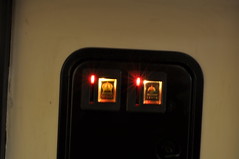On my Sega Star Trek Captain’s Chair restoration; I had to install a HAPP Coin Door because I’ve been unable to locate an original door. This Restoration is featured at AustinModders.com or KLOV.com for those that are interested in the complete project. Anyway, while installing my custom Coin Door inserts; I decided I wanted to modify the stock HAPP coin “guides”. The stock guides look to be black ABS and well … just don’t do it for me. The stock guides are shown here:

you can see the tiny little square just above the coin slot. This is the area we are going to target with this modification. Once you take apart the coin door; you’ll see guide is a piece of formed black abs:

Once I had this guide out; I measured it using a pair of Digital Calipers and layed it out in Corel Draw X4
:

The “nubs” would be laser cut out of 1/8″ Red transparent Acrylic and the blanks would be cut out of black opaque acrylic.

The top of the red “nub” was sandblasted to give it a frosted looks so it’d defuse the light as it exits the nub. When assembled the new guide looks like this:

A 1206 Red LED was soldered into the red acrylic’s pocket with red rework wire attached to the anode and black to the cathode.

I need to drill the coin chute to route the LED’s wires:

and I route the wires out the top side of the chute:

Now that I have the LEDs wired in… what am I going to use them for? Well; I decided I wanted to run the LEDs simular to the Series’ Red Alert indictors I viewed a couple of youtube videos and did some wiki searches; but couldn’t find a “factoid” which gave me the timing of a TOS Red Alert indicator. Therefore; I just decided to make timing which would be pleasing to my eye. If anyone knows for sure a flash target; let me know or leave comment and I’ll figure out the correct timing circuit to flash at that rate.
Anyway; I decided to go with a somewhat simple 555 timer circuit. I have decided to release this design under to the public under the TAPR Non-Commercial Open Hardware License which indicates:
You may make products based upon this design, provided you do not make more than ten units in any twelve month period for your personal use.
The 555 timer operates in Astable mode governed by R1,R2, and C1.
Schematics :
The current implementation of the circuit has an “on” time of ~2.6 seconds and an off time of ~1/3 of a second. There is a RC timer made up of R3 and C2 which allows the LED to “wink” into it’s on state. LEDs D1 and D2 are driven by the 2N3904 transistor and wink on at the same time… Rather than do a current mirror; I decided to let D2’s current ~= D1s current given the transistor’s common-base current gain… IE alpha = beta/(beta+1) which @ ~20mA the 3904’s beta is a minimum of ~90… so alpha is .989 the current of D1. The circuit uses the RST pin of the 555Timer to add additional stability by putting a reset delay on the flipflop in the 555 at ~5seconds. Overkill; proably – but should be very reliable.
The current in the LEDs is controlled by R9 a series resistor intending to limit the current. It was emperically derived using SPICE as a starting point… and then the circuit breadboarded to maximize to 18mA of current flow. D4 is a schottky diode to protect the 555 from reverse wiring mistakes. The LEDs were left unprotected because they and the BJT are diodes … so shouldn’t be impacted by reverse wiring mistakes; additionally, the LEDs voltage drop is already ~2V.. so the 0.1-0.3V voltage drop of D4 might effect brightness.
The PCB is designed as a two layer PCB with through-hole parts on the top layer to enable those less skilled with a soldering iron to build the circuit.

Red Alert LED Fab B Top Layer w/ Silkscreen

Red Alert LED Bottom w/ Silkscreen
For those without PCB layout tools; a bare PCB is available from the batchpcb service for under $11. You can purchase the boards from this link:
http://batchpcb.com/index.php/Products/68503
The Bill Of Materials (BOM) of the board is available from Digikey for under $6 (as of the time of this post). A CSV file with the digikey part numbers is here: HappLEDWink_r2.bom.csv
Here’s a package of the materials above as a single download: HAPPBlink_pkg.zip
Here is the the prototype assembled:

Next I needed to mount the PCB inside the coindoor. Since this is a modern replacement HAPP door; I decided to drill and put some #6-32 hex standoffs inside the door. I taped the holes and also added some epoxy to keep the standoffs in place:

I mounted the PCB:

The rework wire is self adhesive; which made it easy to route the led wires back to the PCB and secure it to the reverse-side of the coindoor.
Last but not least; I connected the power to the +5V circuit at the base of the 555 lamp on the coindoor. the lamp circuit on the Sega Star Trek is tied to the +5V PSU… it isn’t 6.3VAC like Pinball Machines.

Here’s the circuit installed and running:

Want to see it in action? Check out our YouTube video:































